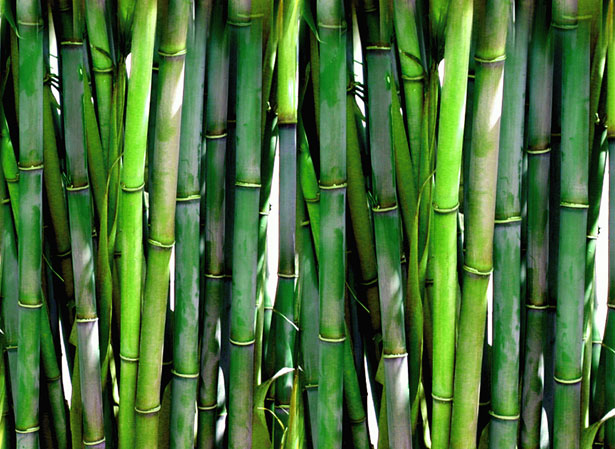Bamboo: the ultimate fabric
By Cara Graham
When we're shopping for clothes, we shop with our hands. The first instinct is to rub the material between fingers — what does it feel like? Is this jumper fluffy or scratchy? Is that dress silky or velvety? One of the softest materials on the market, in my humble opinion, comes from a source that may surprise: bamboo.
Measured against cotton, bamboo boasts of a higher rating of softness,¹ almost like that of cashmere.² Bamboo fabric is naturally hypoallergenic and anti-static, meaning it is gentle on sensitive or eczema-prone skin. It's also thermo-regulating, which makes it great investment for year-round wear.
Bamboo shows ‘excellent’ UV protection results and, compared to cotton, possesses a better ‘moisture vapour permeability’.³ In other words, the material is more breathable, with moisture-wicking properties that draw sweat away from the body. Bamboo fabric shows up to three times the antibacterial activity against E. coli and S. aureus when compared to cotton and viscose. The combined effect of being antibacterial and highly breathable means clothes stay fresher for longer, so it’s totally justified to squeeze one more wear in before laundry day.
Upgrading your wardrobe to bamboo equals downsizing your climate impact too. There are three main areas in the textile industry that cumulatively result in a garment’s climate impact:
- Growing the raw material — how much land, water, fertilisers are needed? Is the plant renewable?
- Manufacturing — are toxic chemicals needed for pre-treatment, dyeing processes, etc? How much electricity is needed?
- Disposability — will the fabric biodegrade?
In the first instance, bamboo is a natural material, like cotton or viscose, so unlike synthetic fibres such as polyester, made from coal, oil or gas, bamboo is renewable. Unlike cotton or viscose, bamboo only needs to be planted once to be continually harvested. This can help prevent soil erosion, as bamboo’s root system can then develop fully.⁴ Bamboo grows extremely quickly in dense clusters and is also able to produce high yields of raw material without the need for fertilizers, a major agricultural polluter. The plant is prolific, able to grow in acidic soil on every continent apart from Europe and Antarctica.⁵ This reduces land consumption, potentially keeping agricultural space free for other crop growth.
In 2013, cotton grown in India used the same volume of water needed to provide 85% of India’s population with 100 L of water every day for a year.⁶ Water shortage and drought are becoming ever more likely in the face of climate change, with 2.7 billion people affected yearly by water scarcity. Meanwhile, a single 250 g cotton shirt uses 2500 L to produce.⁷ Bamboo, however, requires very little water, having no need for additional irrigation in its ability to sustain growth from natural rainfall.⁸
Furthermore, bamboo can also act as a carbon sink, sponging up greenhouse gases from the atmosphere. In fact, per acre, bamboo is able to sequester five times the tonnage of carbon dioxide as the same area of trees.⁹ The production of bamboo products — fabrics and other construction materials — on an industrial scale can be labelled as 'carbon neutral', a huge possibility for reducing the global carbon footprint.¹
The manufacturing process used to create bamboo fabrics is straightforward, requiring it to be boiled before adding biological enzymes. The abandonment of toxic chemicals in favour of natural treatments greatly reduces bamboo's environmental impact of bamboo compared to other textiles.² As a natural material, bamboo is also fully biodegradable. At the end of its life, depending on the specific garment, if made from 100% bamboo, or a blend of 100% natural fibres, your bamboo T-shirt is fully biodegradable, helping reduce waste going to landfill.³
Shopping more sustainably doesn’t necessarily have to mean not shopping at all, just making more mindful choices. Bamboo clothing lines offer a simple alternative to cotton or synthetic fabrics, helping you help the planet in comfort and in style.
─
1. Mishra, R., Behera, B. & Pada Pal, B., 2012. Novelty of bamboo fabric. The Journal of the Textile Institute, 31 May, pp. 320- 329.
2. Bamboo Clothing, n.d. Bamboo Clothing. [Online] Available at: https://bambooclothing.co.uk/ [Accessed 31 October 2020].
3. Mishra, R., Behera, B. & Pada Pal, B., 2012. Novelty of bamboo fabric. The Journal of the Textile Institute, 31 May, pp. 320-329.
4. Boody, n.d. Boody. [Online] Available at: https://boody.co.uk [Accessed 31 October 2020].
5. van der Lugt, P., Vogtlander, J., van der Vegte, J. & Brezet, J., 2015. Life Cycle Assessment and Carbon Sequestration; the Environmental Impact of Industrial Bamboo Products. s.l.:s.n.
6. Leahy, S., 2015. World Water Day: the cost of cotton in water-challenged India. The Guardian, 20 March.
7. Water Footprint Network, n.d. Water Footprint. [Online] Available at: https://www.waterfootprint.org/en/ [Accessed 31 October 2020].
8. Waite, M., 2009. Sustainable Textiles: the Role of Bamboo and a Comparison of Bamboo Textile Properties, New York City: Journal of Textile and Apparel, Technology and Management.
9. Waite, M., 2009. Sustainable Textiles: the Role of Bamboo and a Comparison of Bamboo Textile Properties, New York City: Journal of Textile and Apparel, Technology and Management.
1. van der Lugt, P., Vogtlander, J., van der Vegte, J. & Brezet, J., 2015. Life Cycle Assessment and Carbon Sequestration; the Environmental Impact of Industrial Bamboo Products. s.l.:s.n.
2. Waite, M., 2009. Sustainable Textiles: the Role of Bamboo and a Comparison of Bamboo Textile Properties, New York City: Journal of Textile and Apparel, Technology and Management.
3. Bamboo Clothing, n.d. Bamboo Clothing. [Online] Available at: https://bambooclothing.co.uk/ [Accessed 31 October 2020].



Comments
Post a Comment